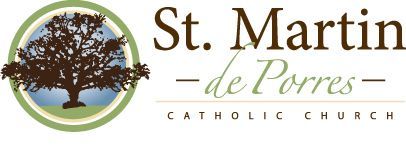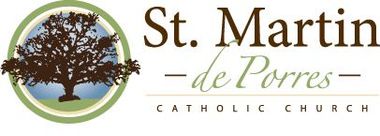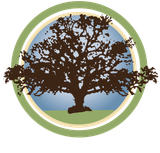About SMdP
Welcome
Thank you for visiting our website and learning more about our growing parish. Please know that you are always welcome at St. Martin de Porres.
Monsignor Jace Eskind
Parish History
In the city of Lake Charles, before integration, several Catholic churches served the Caucasian community of Lake Charles. In these churches there were sections set aside to accommodate the people of color who lived in the city and surrounding area. In the early 1950’s, there were two Catholic churches to serve the people of color in Lake Charles. Sacred Heart was the oldest and served the Central part of the city. Immaculate Heart of Mary, a newly formed parish, served the North Lake Charles community.
Many African Americans lived in South Lake Charles in several different communities. Many had no means of transportation, as it was a farming community of low economic resources, although many were landowners. The majority of the people in the community were related to each other, so it was no problem to get together and decide what had to be done. One of the pioneers and landowners of the Prien Lake community saw a great need. Mr. Frank Granger, the patriarch of the community, began having Mass in his home when he could get a priest to come on a Sunday morning. One of the early altar servers who served in Mr. Granger’s home was the late renowned Zydeco player, Wilson “Boozoo” Chavis.
Seminarians and Nuns came from Sacred Heart Church to teach catechism. Teaching was done in several yards, under the trees. Some of the people who had classes in their yards were Mrs. Victoria Hollier, daughter of Mr. Granger, Mr. & Mrs. Preston Guillory, Mr. & Mrs. Prien Duhon, and several more people in the community. Mrs. Hollier taught catechism when no other teacher could be there.
First Communion & Confirmations were held at Sacred Heart Church. Due to the lack of transportation, some people were not confirmed until they grew up and either moved to town or obtained transportation. Many people remember riding into town for Confirmation or First Communion on the back of hay trucks driven by Mr. Preston Guillory, Mr. Frank Keno and others; and some even in wagons and buggies pulled by horses.
Mrs. Clara Duhon, one of Mr. Granger’s granddaughters, worked for Raymond & Natalie Vincent, a prominent Lake Charles family. Mrs. Vincent was concerned about the lack of a Catholic Church in the Prien Lake community. When Mrs. Vincent learned that Mr. Granger was having Mass in his home, she sent him a message that she would donate money to build a church in the Prien Lake community if he donated the land. Mr. Granger agreed, thus the beginning of St. Martin de Porres. It was constructed as a Mission Chapel served by the priests of Sacred Heart Parish.
Mr. Fanner Guidry & Mr. Elmo Singleton were the carpenters who built the Chapel. Many volunteers from the community assisted them. Mr. Frank Granger enjoyed sitting in the yard and watching the men work.
According to Mrs. Selidia Ryan, the first Mass was celebrated at St. Martin de Porres on Christmas of 1951 in a small one room Chapel. It was under the leadership of Sacred Heart until February 1970 when the Chapel became part of Our Lady Queen of Heaven Parish.
Some parishioners have good memories and have given their versions of the early days of St. Martin Chapel. There were no collection baskets so Mr. John Ryan & Mr. Charlie Granger would pass their hats for the offertory. Mr. Charlie Granger, son of Frank, cut the grass with a mule pulling a hay mower, assisted by Mr. John Ryan with a push mower- no engine. Mr. Herman Granger, son of Charlie and grandson of Frank, remembers these things along with other details. His wife, Mrs. Elnora Granger, remembers selling coffee and donuts after Sunday Mass to raise money. The ladies of the Parish put a small table outside to sell the coffee and donuts because the building was so small.
Dr. Murray Martin, a Lake Charles physician and member of Sacred Heart, donated a statue of St. Martin de Porres to the Chapel. When Hurricane Audrey blew through the area on June 27, 1957, the Prien Lake community was spared any major damage. However, there was minor damage to buildings. The church was blown off its blocks and the statue of St. Martin was broken. House mover, Mr. Edward Duhon (grandson of Frank Granger), replaced the chapel on its blocks. The church later bought a small house for $500.00 and again Mr. Duhon donated labor to move and attach it to the chapel. Thus the beginning of the enlargement of the church building.
There were many improvements and additions. Sacred Heart donated the top floor of their old convent. Again, Mr. Duhon was called upon to move the structure to St. Martin’s with the help of many volunteers. This structure was used as the addition of the hall and other improvements. The grotto was built by Paul Higgins and tiled by Leroy Hollier, another of Mr. Granger’s grandsons. They were helped by many men of the community, among them Iver Lee Sonnier and Henry Ryan.
There were no regular altar servers. Mr. James Joseph remembers teaching young boys like Milton Ryan and Frankie Granger to be altar servers. Mr. Joseph also acted as altar server when none of the young men were available. After St. Martin’s became part of Our Lady Queen of Heaven parish, and Vatican II was enacted, lay ministers were needed to help serve communion. Mr. Joseph and Mrs. Agnes Duhon became the first lay ministers at St. Martin de Porres Chapel.
Music Ministry and Catechism became a part of the St. Martin’s community. In the late 60’s and early 70’s Sandy Gay and her sister Kathy would come to teach catechism. They also provided music at Sunday mass. Sandy started the first Catholic Youth Organization (CYO) at St. Martin’s. In the 80’s, Sr. Elaine Schaeffer and Tina Higgins taught catechism. Tina also reformed the CYO organization. During this time, Eva Bellamo began providing the music ministry for the Mass. In 1987, Ms. Leola Collins began playing the organ and singing for Mass, In 1994 she formed a Youth Choir with 4 young girls from the community – Kela Watley, Nickie Lemelle, Courtney Predium, and Davianne Predium. During that same year, Ms. Collins instituted a Youth Lector program featuring Desiree’ Guillory, Marty Guillory, D.J. Higgins, Jamila Williams, and Tara Clemons.
The entire community pulled together and held many Zydeco dances as major fund raisers. BooZoo Chavis played music for many of the dances. The ladies sold gumbo, pies, and boudin.
St. Martin’s is known to have the best barbeque dinners around. The men start their fire around midnight, begin cooking before day on Sunday morning while the women begin fixing the trimmings. The dinners are ready when 8:00 Mass is done. It was hard to sit in Mass and concentrate because of the aroma of all the smoke and the food. Bar-B-Q’s are always sell out because the cooks have a reputation for being the best in the area - men and women!
St. Martin’s annual bazaar, with its famous barbeque dinners, became the primary method of fundraising. The bazaars were enjoyed by all the parishioners of St. Martin’s, as well as the residents of the Prien Lake community.
St. Martin de Porres...Our Saint
Saint Martin de Porres was born in Lima, Peru on December 9, 1579. His mother, Anna Valazquez, a free black woman and his father, John de Porres, a Spanish nobleman. John de Porres was disturbed by the dark skin of Martin and that of his younger sister, Joan, and for many years abandoned his children.
Martin exhibited a call to holiness even in childhood. Many times, Anna would send Martin to market with a few coins and a basket to purchase food and Martin would return home penniless and with an empty basket. Martin felt a great need to help the poor and would use the money to aid those in need. If Martin came across a church on his way to market, he always stopped to greet and visit with his Heavenly Father and the Blessed Virgin Mary, to whom he had a great devotion.
When Martin was eight years old, his father decided that it was time to accept his children and brought them to live with him in Ecuador, where he held a government position. During the four years the children were with their father, he tended to their education and spent his free time with them. When he was sent to govern Panama, Joan was entrusted to the care of an uncle and Martin returned to Lima to be with his mother.
At the age of twelve, Martin had to choose a trade to help earn a living for himself and his mother. Martin trained to be a barber, which in those days meant not only cutting hair and beards, but also letting blood, treating wounds and fractures, and even prescribing medicine for the more ordinary cases of illness. A barber was in fact, at the same time a surgeon, doctor and pharmacist. Martin could have earned a great deal of money and lived in comfort with his mother, but the same charity which drove him as a small child, now moved him to devote himself to the poor. On a typical day, he set out at daybreak and along the way between his home and the shop, stopped for long periods of time in the church of St Lazarus, serving at many Masses. After having spent the whole day in the effort to perfect himself in his profession and use it to help the poor, he shut himself up in his room to feed his soul with spiritual reading and prayer.
Over time, the cry of Christ dying on the cross – “I thirst”, had aroused in Martin a thirst for the honor of God through the salvation of souls, and he felt an irresistible desire to respond with all the ardor of his soul. By the age of fifteen, Martin chose to present himself to the Friars Preachers of the monastery of the Holy Rosary. He requested the humblest post in the monastery; that of a “donado” – a lay helper. The donados took upon themselves the heaviest tasks and were considered as ranking below the lay brothers. John de Porres, his father, did everything in his power to have Martin become a lay brother rather than a donado but for years Martin refused and remained a lay helper.
Martin’s work in the monastery included sweeping the cloisters and the corridors and cleaning the toilets. Martin seized his broom and had it in his hands so often that it later became a distinguishing mark in pictures and statues of Martin de Porres. His skills as a barber and doctor lead the superiors of the monastery to entrust Martin with the care of the sick and he resumed the full exercise of his profession.
Martin proved to be a great organizer and eventually founded an orphanage, a hospital, schools and a home for young women to stay in before being married. Martin’s charity embraced not only the people of Lima but even animals that would come to him to be healed.
Martin spent his whole life doing good for others. He practiced severe austerities, fasting daily and scourging himself three times during the night. Martin wore only the most thread bare habit and an iron chain around his waist.
Martin predicted his own death in the fall of 1639 when he became ill with a type of malaria. Filled with love for God, he asked for the Sacraments and said, “This is the end of my pilgrimage on earth”.
With his Dominican Brothers around his bed chanting the Salve Regina and the Creed, Martin died on November 3, 1639, at the words: “…and he became man…”
Martin was canonized by Pope John XXIII on May 6, 1962.


